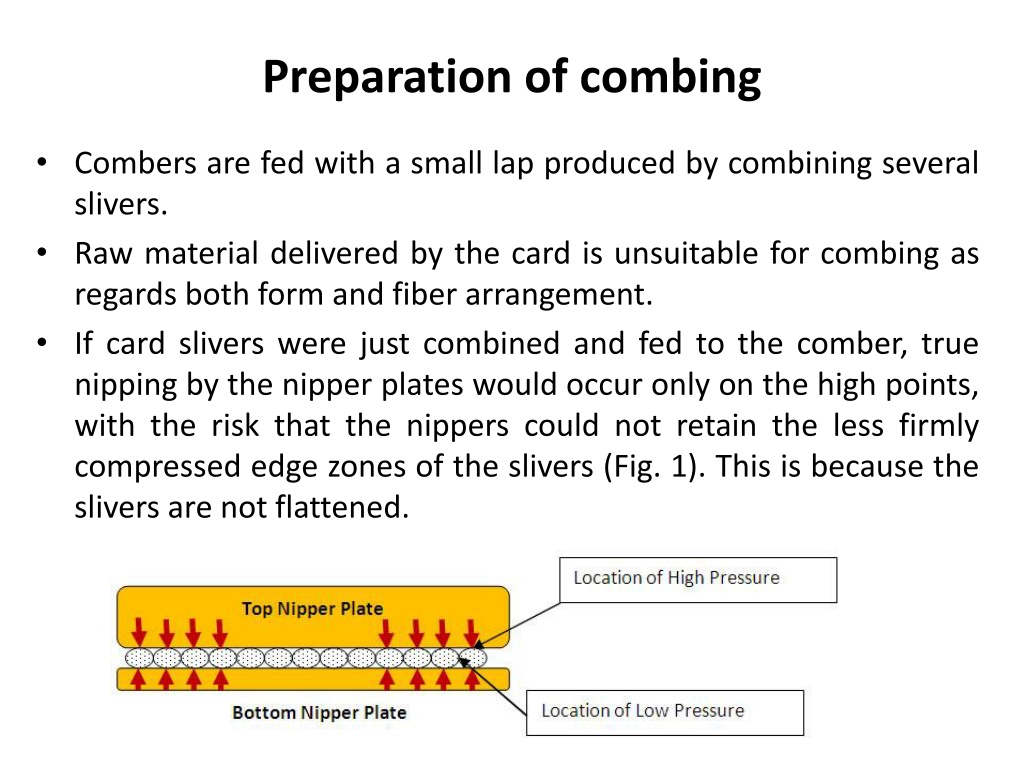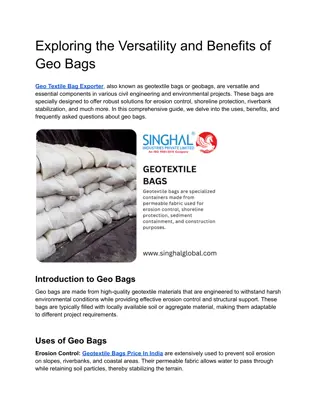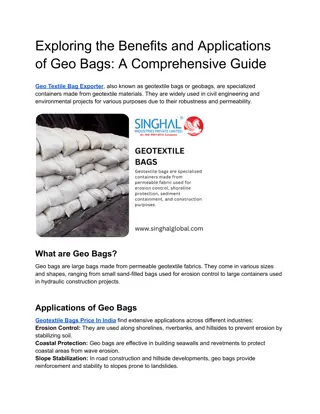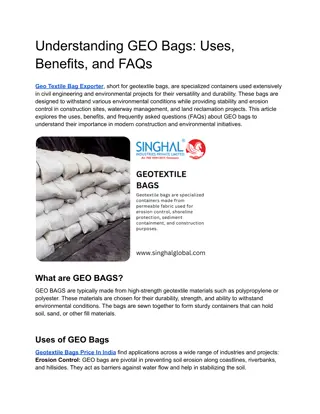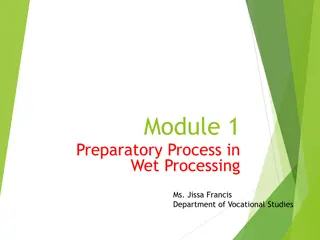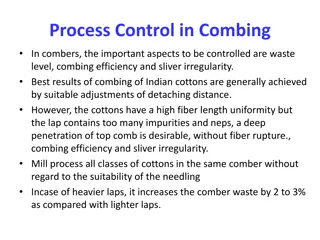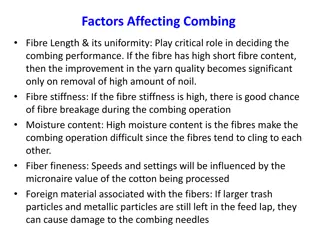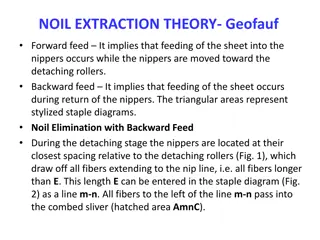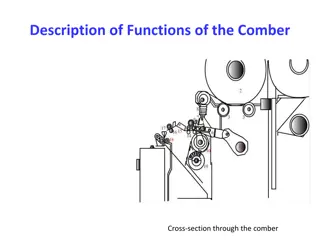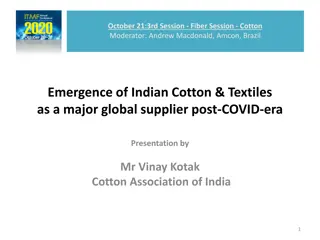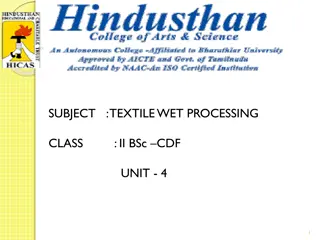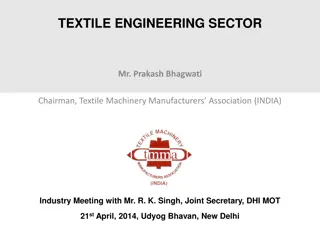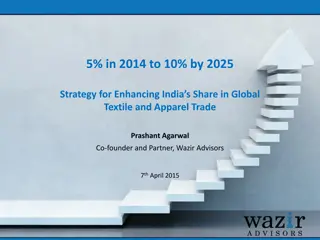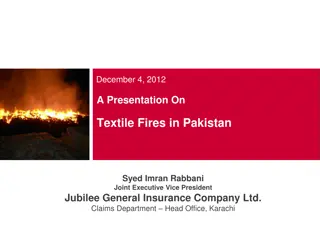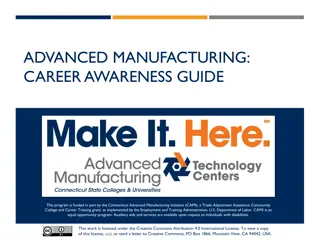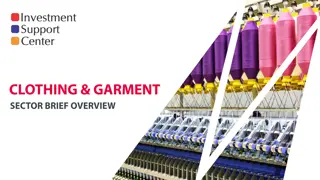Understanding Material Preparation for Combing Process in Textile Manufacturing
Material preparation plays a crucial role in the combing process in textile manufacturing. It involves feeding combers with a small lap, ensuring fibers are evenly arranged and parallelized for efficient combing operation. Lack of parallelization can lead to fiber loss and poor quality output. Proper preparation methods such as batt doubling can help improve the quality and economics of the combing process.
Download Presentation

Please find below an Image/Link to download the presentation.
The content on the website is provided AS IS for your information and personal use only. It may not be sold, licensed, or shared on other websites without obtaining consent from the author. Download presentation by click this link. If you encounter any issues during the download, it is possible that the publisher has removed the file from their server.
E N D
Presentation Transcript
Preparation of combing Combers are fed with a small lap produced by combining several slivers. Raw material delivered by the card is unsuitable for combing as regards both form and fiber arrangement. If card slivers were just combined and fed to the comber, true nipping by the nipper plates would occur only on the high points, with the risk that the nippers could not retain the less firmly compressed edge zones of the slivers (Fig. 1). This is because the slivers are not flattened.
Preparation of combing The fibres could then be pulled out as clumps by the circular cobs during combing. A sheet with greatest possible degree of evenness in cross section, with uniform thickness is required as in-feed to comber. Good parallel disposition of the fibers within the sheet, along the length of the lap sheet is a further prerequisite. Appropriate preparatory machines are needed to prepare the material so that it meets requirements. Fibers projecting from the nippers
Disposition of the hooks must also be taken into account. If the comber is to straighten hooks, then the fibers must be presented to it with leading hooks. The carded slivers have trailing hooks as the majority hooks (more than 50%) as the sliver emerges out of the calendar rollers in the carding machine. Each time the sliver is packed in a can and taken out, the majority hooks change. Sliver passage from carding to comber
Having even number of processes in between card and comber will ensure that majority hooks presented to combing are leading hooks. The two preparation methods: conventional method (Batt doubling) and modern method
How does material preparation affect Combing? Preparation of feed in Batt Parallelization of the Fibers in the Batt The degree of parallelization has a very great influence on the result of the combing operation, of both economics and quality. Lack of parallelization and longitudinal orientation, leads to elimination of longer fibers together with the noil. Due to this, they pluck and tear at the stock, thereby carrying away bunches of fibers. Amount of noil decreases proportionately with increased parallelization of the fibers and with a decrease in batt thickness.
While detaching, between one fifth and one sixth of the fibers presented to the detaching rollers are drawn out of the batt. This means only few fibers are drawn out of a thick layer of feedstock. During this stage, impurities, neps, foreign matter and so on are held back in the sheet because of the retaining power of the thick layer. This retaining power, and hence the so-called self-cleaning effect of the batt, will be all the greater the higher the disorder of the fibers within the sheet. If the fibers have an excessively high degree of parallelization, the retaining power of the batt can be so severely reduced that it is no longer able to hold back the neps as it usually does. Some of these neps also pass through the top comb. Neppiness of the product is increased. A second disadvantage is that if the fibers are too highly ordered, the single layers of the lap do not hold together well and mutual separation layer from layer is disturbed. A high degree of parallelization always leads to considerable hairiness of the lap. Furthermore, the lap weight must be kept low.
Batt Thickness The self-cleaning effect of the batt exerts a considerable influence on the combing operation. This effect arises from the retaining power of the fibers relative to impurities, which depends not only on the disorder of the fibers but also on their quantity. A thick batt always exerts greater retaining power than a thin one. Adversely, a thick batt always exerts a heavy load on the comb and this can lead to uncontrolled combing. Fiber farthest from the circular combs may escape the combing operation,. The unfavorable effect of overloading the comb is greater than the favorable effect of the retaining power of the sheet. Depending on staple length & Micronaire value), the ideal batt weight lies between 72 and 80 ktex for short and medium staple cotton, and between 64 and 74 ktex for long staple cotton.
Evenness of Batt Sheet The more even the batt sheet (web) is across its width, the better the clamping effect at the nipper clamping line. It is very important that slivers are arranged neatly relative to one another and evenly over the entire working width at lap machine. The most effective method of obtaining a high degree of evenness of the sheet is high doubling in sheet form, as in the classical system, . In this respect, the operation of the ribbon lap machine was always ideal in the past. Nowadays, however, the disadvantages far exceed the advantages, e.g. the very high fiber parallelization. Caused by the high drafts in two stages, resulting in insufficient cohesion of the sheet. It does not permit high speeds and therefore high productivity compared with the sliver lap system. The self-cleaning effect also suffers from this high degree of parallelization.
The Disposition of the Hooks Fibers must be presented to the comber so that leading hooks predominate in the feedstock. If the batt is fed in the wrong direction, the number of neps rises markedly. It also increases the soiling and loading of top combs and circular combs, and finally the neppiness. Both quantity and form of fiber hooks depend mainly upon the stiffness of the fibers; the latter rises to the second or third power with increasing coarseness of the fibers . The hooks also display different forms; fine, long fibers will always exhibit more and longer hooksthan short, coarse fibers. The role of fiber hooks in the spinning process therefore becomes more significant as fibers become finer.
PREPARATION OF THE STOCK FOR COMBING Conventional web doubling process employs a sliver lap machine followed by a ribbon lap machine (Fig. 8, 9, 10) but ;today modern machine has mostly two passage (Fig. 5) sliver doubling process, in which a normal draw frame (without leveling) provides the first passage and a sliver doubling machine follows as the second passage Overview of the two laps forming processes in use
Conventional System In this process the sliver lap machine is first step machine in which. 24 slivers from card are usually fed together and side by side over a table into a drafting arrangement. By this process a loose form of web is created with a small draft of around 1.5. After pressing and smoothing, this web is rolled up to a lap by calendar rollers. Top view of a sliver lap machine Sliver lap machine
Modern Preparation System The idea of creating a comber feeding lap by a single web forming process directly in front of the comber using a draw frame passage in front of this web former, is developed in 1948 by a Company, called the super lap machine. Web former always follows a normal draw frame. On the Web Former machine the material flow starts with the creel consisting of two feed rails. Web Former lap forming machine
Altogether, finally gives a total of 24 doublings. The pre-draw frame slivers run over a guide bridge above the service alley and also over several guide rollers to the drafting system at 2 . The web created by the draft of 1.3 to 2.5 passes over two deflecting plates onto the web table on which the webs are superimposed. Calendar rollers draw these superimposed webs from the table to the lap winding assembly. The strong compression created between the calendar rollers forms a new web, which is rolled into a lap in the lap forming assembly. Empty tubes are automatically exchanged for full laps. Transport of the laps to the combing machine is semi-automatic or fully automatic.
feed The first part of the machine is a creel on each side material is feed using two drafting arrangements from maximum. 28 cans obtained from the draw frame. Here also the slivers are guided over a service alley (one on each side) to the drafting arrangement (Fig.13). The Web Former machine features a 3-over-3 roller, two-zone drafting arrangement The pneumatically weighted top rollers can be continuously adjusted from minimum to maximum per top roller. Draft distances are individually variable, and the draft levels in each of the break and main draft zones are also variables. Upper and lower clearer aprons in combination with a suction system keep the rollers clean. The easily accessible drive for the drafting arrangement is in an enclosed housing and is fitted with appropriate change gears and oil spray lubrication.
Lap Winding Assembly Conventional System After passing through the web table, web runs through four calendar rollers (Fig. 14, 1). The pressure generated by two membrane cylinders can be adjusted up to 16 000 N. The calendar rollers are followed by two winding rolls (2) and a lap tube holding device (3) with a lap weighting device. Final lap is obtained through calendaring process and quality of lap depends on lap winding assembly. The required weighting pressure (up to 10 000 N), derived from a piston, is transferred via a pivoting lever to the weighting frame and thus to the lap tube. The Web Former has an automatic lap pressure control which adapts the pressure according to the lap diameter. This is due to increase in diameter of the lap raises the weighting frame, so that pressure increases according to the diameter. The increasing size of the lap is adjusted using setting screws. The machine stops when a preset lap length is reached, whereupon an automatic device replaces the full lap by an empty tube.
Former speed control arrangement on the Web Former In the former system the Web Former machine did not run at constant speed, since this would mean choosing the speed according to the most critical phase of lap winding, i.e. when lap winding was close to completion. However, this meant losing productivity. That is why machinery manufacturers adapted the speed of the machine to the buildup of the lap by means of the speed control set (Fig. 15). So, for example, if a final speed of about 70 m/min was required, the machine started with a speed of 140 m/min.
System Incorporating the Latest Technology Since production speeds using winding system based on calendar rollers have reached their limit, machinery manufacturers developed a new lap winding system . The new lap winding system makes use of a unique belt tension and pressure arrangement. Comparison between different winding systems
The winding belt (Fig. 17, 1), with a width similar to that of the laps, surrounds the lap to form a circumferential pressure area (modern-shaped) ranging from 180 to 270 from starting to full lap. Fiber guidance and pressure distribution applied by the modern principle allow constant production (i.e. constant speed during winding of the lap) at speeds of up to 180 m/min over the entire lap buildup. Modern winding process
